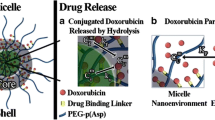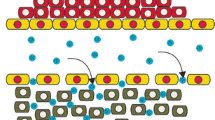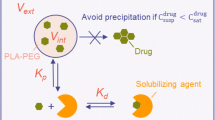Abstract
Purpose
To compare traditional dialysis- and novel solvatofluorochromism (SFC)-based methods for accurate determination of drug release profiles for nanoparticle drug carriers.
Methods
Polymer nanoassemblies (PNAs) varying in drug release patterns were prepared using poly(ethylene glycol), poly(ethylenimine), hydrophobic excipients (palmitate and deoxycholate), and model hydrophobic anticancer drugs with clinical relevance (carfilzomib and docetaxel). Nile blue (NB) was used as a model SFC dye quenching fluorescence in water yet emitting strong fluorescence in the presence of hydrophobic drugs within PNAs. Drug release kinetics were measured by dialysis- and SFC-based methods, and analyzed by mathematical modeling of free drug, spiked drug, and encapsulated drug release.
Results
The dialysis method overestimated drug remaining in PNAs because it included released drug in measurements, whereas the SFC method successfully distinguished drugs entrapped in PNAs from released in solution and thus provided more accurate drug release patterns. However, mathematical modeling revealed that the dialysis method would be less influenced than the SFC method by hydrophobic excipients modulating drug diffusion within PNAs.
Conclusions
In comparison to the dialysis-based method, the SFC-based method would allow for real-time spectroscopic determination of drug release from PNAs and potentially other nanoparticle drug carriers with improved convenience and accuracy.










Similar content being viewed by others
Abbreviations
- 2P:
-
PEG-PEI
- 2PN:
-
PEG-PEI-NB
- 3P:
-
PEG-PEI-PAL
- 3PN:
-
PEG-PEI-PAL-NB
- CFZ:
-
Carfilzomib
- DOC:
-
Docetaxel
- DOCA:
-
Deoxycholic acid
- NB:
-
Nile blue
- PAL:
-
Palmitic acid
- PEG:
-
Poly(ethylene glycol)
- PEI:
-
Poly(ethylenimine)
- PNAs:
-
Polymer nanoassemblies
- SFC:
-
Solvatofluorochromism
- TNAs:
-
Tethered polymer nanoassemblies
References
Reichel D, Lee MJ, Lee W, Kim KB, Bae Y. Tethered polymer nanoassemblies for sustained carfilzomib release and prolonged suppression of proteasome activity. Ther Deliv. 2016;7(10):665–81.
Dickerson M, Howerton B, Bae Y, Glazer E. Light-sensitive ruthenium complex-loaded cross-linked polymeric nanoassemblies for the treatment of cancer. J Mater Chem B Mater Biol Med. 2016;4:394–408.
Lee HJ, Bae Y. Pharmaceutical differences between block copolymer self-assembled and cross-linked nanoassemblies as carriers for tunable drug release. Pharm Res. 2013;30(2):478–88.
Lee HJ, Bae Y. Brushed block copolymer micelles with pH-sensitive pendant groups for controlled drug delivery. Pharm Res. 2013;30(8):2077–86.
Cao P, Ponta A, Kim JA, Bae Y. Block copolymer crosslinked nanoassemblies co-entrapping acridine yellow and doxorubicin for cancer theranostics. Br J Pharm Res. 2013;3:536–47.
Lee HJ, Ponta A, Bae Y. Polymer nanoassemblies for cancer treatment and imaging. Ther Deliv. 2010;1(6):803–17.
Curtis LT, Rychahou P, Bae Y, Frieboes HB. A computational/experimental assessment of antitumor activity of polymer nanoassemblies for ph-controlled drug delivery to primary and metastatic tumors. Pharm Res. 2016;33:2552–64.
Ponta A, Bae Y. Tumor-preferential sustained drug release enhances antitumor activity of block copolymer micelles. J Drug Target. 2014;22(7):619–28.
Scott D, Bae Y. Block copolymer crosslinked nanoassemblies co-entrapping hydrophobic drugs and lipophilic polymer additives. J Pharm Drug Deliv Res. 2013;2(1000116):1–5.
Ponta A, Bae Y. PEG-poly(amino acid) block copolymer micelles for tunable drug release. Pharm Res. 2010;27(11):2330–42.
Bae Y. Drug delivery systems using polymer nanoassemblies for cancer treatment. Ther Deliv. 2010;1:361–3.
Howard MD, Ponta A, Eckman AM, Jay M, Bae Y. Polymer micelles with hydrazone-ester dual linkers for tunable release of dexamethasone. Pharm Res. 2011;28:2435–46.
Eckman AM, Tsakalozou E, Kang NY, Ponta A, Bae Y. Drug release patterns and cytotoxicity of PEG-poly(aspartate) block copolymer micelles in cancer cells. Pharm Res. 2012;29(7):1755–67.
Dickerson M, Winquist N, Bae Y. Photo-inducible crosslinked nanoassemblies for pH-controlled drug release. Pharm Res. 2014;31(5):1254–63.
Ao L, Reichel D, Hu D, Jeong H-Y, Kim KB, Bae Y, et al. Polymer micelle formulations of proteasome inhibitor carfilzomib for improved metabolic stability and anti-cancer efficacy in human multiple myeloma and lung cancer cell lines. J Pharmacol Exp Ther. 2015;355:168–73.
Lee HJ, Bae Y. The effect of core crosslinking degree on drug release patterns of pH-sensitive block copolymer crosslinked nanoassemblies. Nano Bull. 2013;2:1302101–9.
Akter S, Clem BF, Lee HJ, Chesney J, Bae Y. Block copolymer micelles for controlled delivery of glycolytic enzyme inhibitors. Pharm Res. 2012;29(3):847–55.
Scott D, Rohr J, Bae Y. Nanoparticulate formulations of mithramycin analogs for enhanced cytotoxicity. Int J Nanomed. 2011;6:2757–67.
Ponta A, Akter S, Bae Y. Degradable cross-linked nanoassemblies as drug carriers for heat shock protein 90 inhibitor 17-N-allylamino-17-demethoxygeldanamycin. Pharmaceuticals. 2011;4:1281–92.
Lee HJ, Bae Y. Cross-linked nanoassemblies from poly(ethylene glycol)-poly(aspartate) block copolymers as stable supramolecular templates for particulate drug delivery. Biomacromolecules. 2011;12:2686–96.
Alani AWG, Bae Y, Rao DA, Kwon GS. Polymeric micelles for the pH-dependent controlled, continuous low dose release of paclitaxel. Biomaterials. 2010;31(7):1765–72.
Bae Y, Nishiyama N, Fukushima S, Koyama H, Matsumura Y, Kataoka K. Preparation and biological characterization of polymeric micelle drug carriers with intracellular pH-triggered drug release property: tumor permeability, controlled subcellular drug distribution, and enhanced in vivo antitumor efficacy. Bioconjug Chem. 2005;16(1):122–30.
Ponta A, Fugit KD, Anderson BD, Bae Y. Release, partitioning, and conjugation stability of doxorubicin in polymer micelles determined by mechanistic modeling. Pharm Res. 2015;32(5):1752–63.
Fugit KD, Xiang TX, du Choi H, Kangarlou S, Csuhai E, Bummer PM, et al. Mechanistic model and analysis of doxorubicin release from liposomal formulations. J Control Release. 2015;217:82–91.
Wu H, Zhu L, Torchilin VP. pH-sensitive poly(histidine)-PEG/DSPE-PEG co-polymer micelles for cytosolic drug delivery. Biomaterials. 2013;34(4):1213–22.
Yadav S, Gupta S. Development and in vitro characterization of docetaxel-loaded ligand appended solid fat nanoemulsions for potential use in breast cancer therapy. Artif Cells Nano Biotechnol. 2015;43(2):93–102.
Li J, Guo X, Liu Z, Okeke CI, Li N, Zhao H, et al. Preparation and evaluation of charged solid lipid nanoparticles of tetrandrine for ocular drug delivery system: pharmacokinetics, cytotoxicity and cellular uptake studies. Drug Dev Ind Pharm. 2014;40(7):980–7.
Dickerson M, Winquist N, Bae Y. Photo-inducible cross-linked nanoassemblies for controlled drug delivery. Pharm Res. 2013;31:1254–63.
Dickerson M, Bae Y. Block copolymer nanoassemblies for photodynamic therapy and diagnosis. Ther Deliv. 2013;4(11):1431–41.
Jin G-W, Bae Y. Reductant-dependent none-partial-complete degradation of block copolymer disulfide crosslinked nanoassemblies. J App Pharm Sci. 2013;3:1–6.
Bera A, Chandel AKS, Kumar CU, Jewrajka SK. Degradable/cytocompatible and pH responsive amphiphilic conetwork gels based on agarose-graft copolymers and polycaprolactone. J Mater Chem B. 2015;3(43):8548–57.
de Andrade DF, Zuglianello C, Pohlmann AR, Guterres SS, Beck RCR. Assessing the in vitro drug release from lipid-core nanocapsules: a new strategy combining dialysis sac and a continuous-flow system. AAPS PharmSciTech. 2015;16(6):1409–17.
Fuchs K, Bize PE, Denys A, Borchard G, Jordan O. Sunitinib-eluting beads for chemoembolization: methods for in vitro evaluation of drug release. Int J Pharm. 2015;482(1):68–74.
Salmela L, Washington C. A continuous flow method for estimation of drug release rates from emulsion formulations. Int J Pharm. 2014;472(1):276–81.
Wasik S, Arabski M, Drulis-Kawa Z, Gubernator J. Laser interferometry analysis of ciprofloxacin and ampicillin diffusion from liposomal solutions to water phase. Eur Biophys J. 2013;42(7):549–58.
Li Z, Paulson AT, Gill TA. Encapsulation of bioactive salmon protein hydrolysates with chitosan-coated liposomes. J Funct Foods. 2015;19:733–43.
Gullotti E, Yeo Y. Beyond the imaging: limitations of cellular uptake study in the evaluation of nanoparticles. J Control Release. 2012;164(2):170–6.
Zhou Y, He C, Chen K, Ni J, Cai Y, Guo X, et al. A new method for evaluating actual drug release kinetics of nanoparticles inside dialysis devices via numerical deconvolution. J Control Release. 2016;243:11–20.
Xie L, Beyer S, Vogel V, Wacker MG, Mantele W. Assessing the drug release from nanoparticles: overcoming the shortcomings of dialysis by using novel optical techniques and a mathematical model. Int J Pharm. 2015;488(1):108–19.
Reichel D, Rychahou P, Bae Y. Polymer nanoassemblies with solvato- and halo-fluorochromic properties for real-time monitoring of drug release and pH-enhanced ex vivo imaging of metastatic tumors. Ther Deliv. 2015;6:1221–37.
Cheng Y, Xu T. The effect of dendrimers on the pharmacodynamic and pharmacokinetic behaviors of non-covalently or covalently attached drugs. Eur J Med Chem. 2008;43(11):2291–7.
Jaimes-Aguirre L, Gibbens-Bandala BV, Morales-Avila E, Ocampo-Garcia BE, Seyedeh-Fatemeh M, Amirhosein A. Polymer-based drug delivery systems, development and pre-clinical status. Curr Pharm Des. 2016;22(19):2886–903.
Chu KS, Hasan W, Rawal S, Walsh MD, Enlow EM, Luft JC, et al. Plasma, tumor and tissue pharmacokinetics of Docetaxel delivered via nanoparticles of different sizes and shapes in mice bearing SKOV-3 human ovarian carcinoma xenograft. Nanomedicine. 2013;9(5):686–93.
Stylianopoulos T, Jain RK. Design considerations for nanotherapeutics in oncology. Nanomedicine. 2015;11(8):1893–907.
Diou O, Greco S, Beltran T, Lairez D, Authelin JR, Bazile D. A method to quantify the affinity of cabazitaxel for PLA-PEG nanoparticles and investigate the influence of the nano-assembly structure on the drug/particle association. Pharm Res. 2015;32(10):3188–200.
Modi S, Anderson BD. Determination of drug release kinetics from nanoparticles: overcoming pitfalls of the dynamic dialysis method. Mol Pharm. 2013;10(8):3076–89.
Cao L, Bornscheuer UT, Schmid RD. Lipase-catalyzed solid-phase synthesis of sugar esters. Influence of immobilization on productivity and stability of the enzyme. J Mol Catal B Enzym. 1999;6(3):279–85.
Roda A, Minutello A, Angellotti MA, Fini A. Bile acid structure-activity relationship: evaluation of bile acid lipophilicity using 1-octanol/water partition coefficient and reverse phase HPLC. J Lipid Res. 1990;31(8):1433–43.
Cho EJ, Holback H, Liu KC, Abouelmagd SA, Park J, Yeo Y. Nanoparticle characterization: state of the art, challenges, and emerging technologies. Mol Pharm. 2013;10(6):2093–110.
Kwon GS, Naito M, Yokoyama M, Okano T, Sakurai Y, Kataoka K. Micelles based on AB block copolymers of poly (ethylene oxide) and poly (. beta.-benzyl L-aspartate). Langmuir. 1993;9(4):945–9.
Luo S, Tao Y, Tang R, Wang R, Ji W, Wang C, et al. Amphiphilic block copolymers bearing six-membered ortho ester ring in side chains as potential drug carriers: synthesis, characterization, and in vivo toxicity evaluation. J Biomater Sci Polym Ed. 2014;25(10):965–84.
Gillies ER, Jonsson TB, Frechet JM. Stimuli-responsive supramolecular assemblies of linear-dendritic copolymers. J Am Chem Soc. 2004;126(38):11936–43.
Duan R, Li C, Liu S, Liu Z, Li Y, Zhu J, et al. A selective fluorescence quenching method for the determination of trace hypochlorite in water samples with nile blue A. J Taiwan Inst Chem Eng. 2015;50:43–8.
Frick AA, Busetti F, Cross A, Lewis SW. Aqueous Nile blue: a simple, versatile and safe reagent for the detection of latent fingermarks. Chem Commun. 2014;50(25):3341–3.
Uchida Y, Maezawa Y, Uchida Y, Hiruta N, Shimoyama E. Molecular imaging of low-density lipoprotein in human coronary plaques by color fluorescent angioscopy and microscopy. Plos One. 2012;7(11):e50678.
Fugit KD, Anderson BD. Dynamic, nonsink method for the simultaneous determination of drug permeability and binding coefficients in liposomes. Mol Pharm. 2014;11(4):1314–25.
Zambito Y, Pedreschi E, Di Colo G. Pharmaceutical nanotechnology. Int J Pharm. 2012;434(1–2):28–34.
Hopfner T, Bluma A, Rudolph G, Lindner P, Scheper T. A review of non-invasive optical-based image analysis systems for continuous bioprocess monitoring. Bioprocess Biosyst Eng. 2010;33(2):247–56.
Beutel S, Henkel S. In situ sensor techniques in modern bioprocess monitoring. Appl Microbiol Biotechnol. 2011;91(6):1493–505.
ACKNOWLEDGMENTS AND DISCLOSURES
DR acknowledges financial support from the University of Kentucky College of Pharmacy Graduate School Allocated Year (GSAY) Fellowship.
Author information
Authors and Affiliations
Corresponding author
Rights and permissions
About this article
Cite this article
Reichel, D., Bae, Y. Comparison of Dialysis- and Solvatofluorochromism-Based Methods to Determine Drug Release Rates from Polymer Nanoassemblies. Pharm Res 34, 394–407 (2017). https://doi.org/10.1007/s11095-016-2070-6
Received:
Accepted:
Published:
Issue Date:
DOI: https://doi.org/10.1007/s11095-016-2070-6




